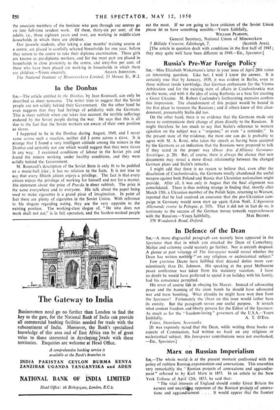The Servant Problem SIR,—In the Spectator of March 24th, Marghanita
Laski discussed the need for competent domestic help for the middle-class professional woman with children. In that paragraph in which Miss Laski refers to the National Institute of Houseworkers she made the following state- ment: " Most of the students go outasllome-Helps, and those who do not will not tend to choose the middle-class household with children for the same reasons that lead the good professional servants to eschew it."
For future reference I think you may like to know the position with regard to the employment of associate members of the Institute. Seven per cent. of the associate members of the Institute who have been trained in Institute Centres have joined the home help services of local authorities. Thirteen per cent. have joined the daily houseworkers services of the Institute, which have been established in thirteen different towns. 'Under this scheme, the workers are employed by the Institute and their services are made available on4 part-time basis to such householders who do not want or cannot afford full-time help. By far the greater number of
the associate members of the Institute who pass through our centres go on into full-time resident work. Of these, thirty-six per cent. of the adults, i.e., those eighteen years and over, are working in middle-class households in which there are children.
Our juvenile students, after taking a nine months' training course at a centre, are placed in carefully selected Households for one year, before they return to the centre to take their diploma examination. These girls are known as pre-diploma workers, and for the most part are placed in households in close proximity to the centre, and sixty-five per cent. of these who have been placed are working in households in which there
are children.—Yours sincerely, AILEEN JOHNSTON. The National Institute of House workers Limited, 53 Mount St., W.I.







































 Previous page
Previous page